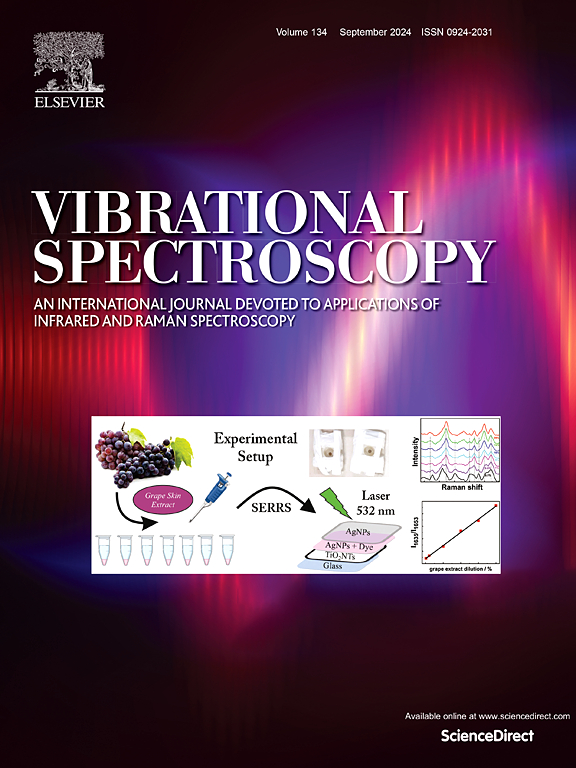Eu3+包裹体结构紊乱导致GdVO4纳米体系中部分锆石向白钨矿型相变的拉曼特征
IF 3.1
3区 化学
Q2 CHEMISTRY, ANALYTICAL
引用次数: 0
摘要
本文报道了在允许的取代掺杂情况下,在含有Eu3+的GdVO4纳米体系中遇到的锆-白钨矿部分相转化的拉曼分析。具体来说,在特征的拉曼模式中,A1g模式属于O-V-O振动,B2 g代表由Eu-O拉伸引起的平移振动模式(~ 258 cm−1)。强烈的高频模式ν2 = 880 cm-1可以描述具有四方对称的理想锆石型构象的四面体[VO4]3-阴离子基的拉伸内部振动。重要的是,在GdVO4纳米体系的室温拉曼研究中,A1g(剪切)和B2g(扭曲)两种拉曼活性模式的重叠表征了所研究纳米体系的白钨矿型特征。在体系中加入Eu3+,由于在基体中Eu3+位点附近可能发生局部相变,导致白钨矿型特征的强度增强。本文着重分析了Eu3+掺杂(1-7 %)导致的白钨矿型信号增强和部分锆石晶格向白钨矿晶格转变,并对其表现模式进行了详细分析。本文章由计算机程序翻译,如有差异,请以英文原文为准。
Raman signature of partial zircon to scheelite-type phase conversion in GdVO4 nanosystem due to structural disordering induced by Eu3+ inclusions
This work reports Raman analysis of zircon-to-scheelite partial phase conversion encountered in GdVO4 nanosystem with Eu3+ around permissible substitutional doping. To be specific, among the Raman modes featured, the A1g mode is attributed to O-V-O vibration while B2 g represents the translatory vibrational mode (∼258 cm−1) attributed to the Eu–O stretching. The intense high-frequency mode, ν2 = 880 cm–1 would describe stretching internal vibration in the tetrahedral [VO4]3- anionic group for an ideal zircon-type conformation with tetragonal symmetry. Importantly, at room temperature Raman studies of GdVO4 nanosystem, the overlap of two Raman active modes namely, A1g (scissoring) and B2g (twisting) characterize scheelite-type characteristics in the nanosystem under study. Incorporation of Eu3+ in the system resulted in enhancing the intensity of the scheelite-type characteristics due to possible localized phase transition around Eu3+ sites in the matrix. The observed scheelite-type signal enhancement and consequently partial zircon lattice to scheelite lattice conversion due to inclusion of Eu3+ doping (1–7 %) has been highlighted and analyzed emphasizing manifested modes in detail.
求助全文
通过发布文献求助,成功后即可免费获取论文全文。
去求助
来源期刊

Vibrational Spectroscopy
化学-分析化学
CiteScore
4.70
自引率
4.00%
发文量
103
审稿时长
52 days
期刊介绍:
Vibrational Spectroscopy provides a vehicle for the publication of original research that focuses on vibrational spectroscopy. This covers infrared, near-infrared and Raman spectroscopies and publishes papers dealing with developments in applications, theory, techniques and instrumentation.
The topics covered by the journal include:
Sampling techniques,
Vibrational spectroscopy coupled with separation techniques,
Instrumentation (Fourier transform, conventional and laser based),
Data manipulation,
Spectra-structure correlation and group frequencies.
The application areas covered include:
Analytical chemistry,
Bio-organic and bio-inorganic chemistry,
Organic chemistry,
Inorganic chemistry,
Catalysis,
Environmental science,
Industrial chemistry,
Materials science,
Physical chemistry,
Polymer science,
Process control,
Specialized problem solving.
 求助内容:
求助内容: 应助结果提醒方式:
应助结果提醒方式:


